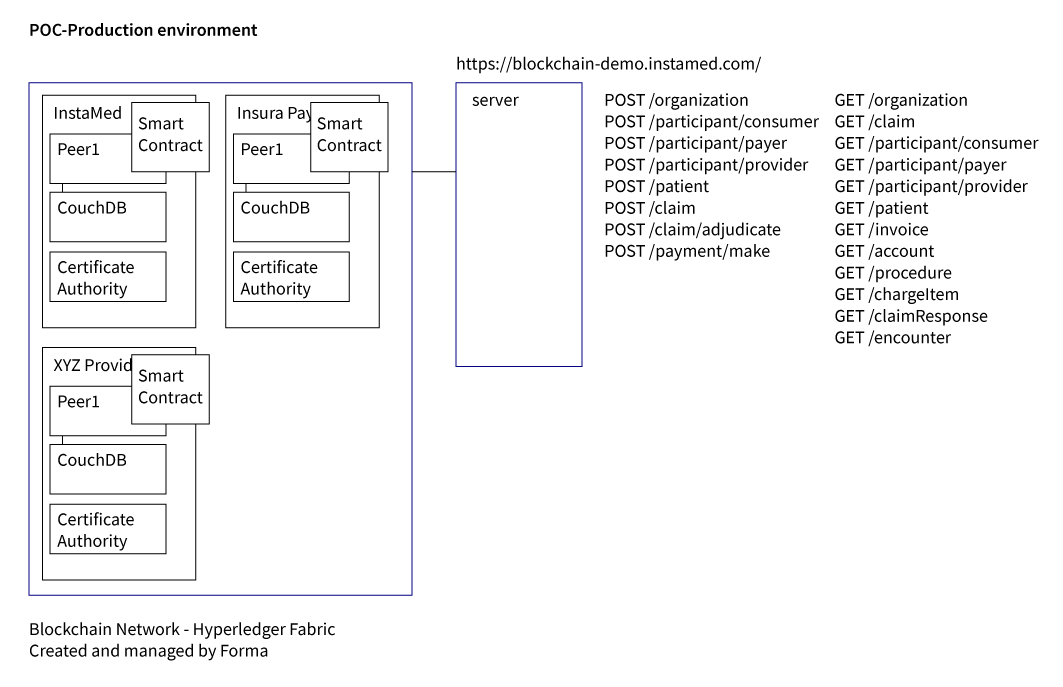PROJECT IS DEPRECIATED. CODE PROVIDED FOR REFERENCE ONLY.
This is a prototype useful for exploring blockchain or as a basis for a project. It is not intended for production use without further modification and testing.
In the InstaMed Innovation Lab, we built a blockchain prototype focused on healthcare payments among providers, payers and patients. One of the prototype’s purposes is to evaluate the value of blockchain in driving a better healthcare payments experience for all stakeholders. Learn more about the project
This is a Hyperledger Fabric blockchain project that implements the FHIR Financial module. It is built with Convector and follows the FHIR spec. A Vuejs demo frontend app is included in the project in /packages/frontend.
The live demo can be found at: https://blockchain-demo.instamed.com/
The live network block browser can be found at: https://blockchain-demo.instamed.com:8443/
A video describing this flow can be found at: https://vimeo.com/325931177/e21834462d
- Node 8.11.0
- Docker Community Edition
- npx
- If you are running in Ubuntu, make sure you meet all the prerequisites for Fabric and Convector - Prerequisites Ubuntu
Detailed instructions for installing on Ubuntu can be found here: https://developers.instamed.com/healthcare-payments-blockchain/install-blockchain-on-linux/
# Install dependencies
npm install
# Start the blockchain and the server
npm start
# Create some mock data automatically to setup the network
npm run mockData
# Start the server
npm run server:start
# You can now run transactions (there's a Postman file included to help you talk to the endpoints "./Fhir Financial.postman_collection.json")
# Read first the section "Identities on the project" of this README
# You should send transactions all transactions from postman_collection.json in the order defined before install the remaining views
# Views are associated to databases and Fabric doesn't generate them until at least 1 value was saved there
npm run views:installThis will:
- Install a development Hyperledger Fabric Network (and remove any previous one) with Hurley.
- Install the chaincode with the name
financialin the network. - Start the NodeJS server.
- Install CouchDB views.
- Instantiate the chaincode servers.
- Create some mock data for you.
To get the front end to work properly, you need to run the postman added in the repository by configuring the fingerprints correctly.
Go to the Postman collection settings and set the value to the variable patientFingerprint to use the same for every transaction after you run npm run user:fingerprint -- $HOME/hyperledger-fabric-network/.hfc-org1/user1 then go and set the value of consortiumAdminFingerprint to npm run user:fingerprint -- $HOME/hyperledger-fabric-network/.hfc-org2/user1 and then value of providerFingerprint to npm run user:fingerprint -- $HOME/hyperledger-fabric-network/.hfc-org3/user1.
- Just start the server in dev mode
npm run server:start. Run this in case after thenpm startyou close the terminal. This won't install the network again, just the NodeJS server.
The front end project makes it possible to visualize blocks in the network as well as its contents.
The current project uses the Byzantine Browser's API to get the blocks from the transactions to the ledger in realtime. For now it uses a fork from WorldSibu that enables TLS in the server.
Make sure you already started the blockchain (healthcare-payments-blockchain) with npm start so a blockchain network is running on your computer with Hurley.
You have to run npm install twice for the backend and the frontend.
# Go outside this folder and clone the repo
git clone https://github.com/worldsibu/byzantine-browser.git
cd byzantine-browser
npm install
cd ui
npm install
npm run build
cd ..Copy the keys from the hyperledger-fabric-network directory. We're assuming here you have installed the byzantine-browser in that same parent directory as the blockchain.
cp $HOME/hyperledger-fabric-network/.hfc-org1/* ./hfc-key-store
Replace the .env in the root of the Byzantine Browser folder (or create it if it doesn't exist) with the information below.
USERID=user1
NETWORK_URL=grpc://localhost:7051
EVENT_URL=grpc://localhost:7052Use your favorite text editor or use Nano
nano .env
(copy text from above and right click to paste into terminal)
control-O
control-X
Run the Byzantine server
./runApiServer.sh
packages/financial-cc: contains the whole smart contract with all its models and controllers.packages/server: contains the server calling the blockchain.chaincode.config.json: links the controllers and packages the config for the smart contract.dev-enva folder containing development environment needed files like the CouchDB views and the installation script.Fhir Financial.postman_collection.json: import this file into Postman to see the queries to the database, follow the numbers in the tasks to create a full flow.
Payer Organizations, Provider Organizations, and Consumer Participants are identified in the blockchain through a fingerprint of a certificate generated from the Certificate authority.
The logic goes as follows:
- A identity (user) is created in the Certificate Authority.
- That user is enrolled in the blockchain network (in the case of the development environment the identity is registered and then enrolled by default).
- Extract the fingerprint from the cert by calling:
# I.e.: npm run user:fingerprint -- $HOME/hyperledger-fabric-network/.hfc-org1/user1
npm run user:fingerprint -- $HOME/hyperledger-fabric-network/.hfc-<org>/<user>- The result fingerprint looks like
A5:EB:E4:1E:8E:86:03:72:00:3F:EA:CA:D2:9D:98:08:CA:70:24:F6. - That same fingerprint will be validated when a transaction is signed by a identity from the blockchain.
- Be sure to pass it throught Postman when registering a new
Payer OrganizationorConsumer Participantas a param calledfingerprint. Transactions will validate that the right identity is trying to perform requests. - For example, to create a Consumer Participant, the following JSON is valid:
{
"participant": {
"id": "Consumer::Bob"
},
"fingerprint": "A5:EB:E4:1E:8E:86:03:72:00:3F:EA:CA:D2:9D:98:08:CA:70:24:F6"
}You will need two different identities. One can be shared between the Payer and InstaMed (working on behalf of the patients) and the other one for a provider. The reason for this is that some data is stored only accessible to some identities (look for Private Collections later in this document), therefore a switch in the identity is made.
Go to the Postman collection settings and set the value to the variable patientFingerprint to use the same for every transaction after you run npm run user:fingerprint -- $HOME/hyperledger-fabric-network/.hfc-org1/user1 then go and set the value of consortiumAdminFingerprint to npm run user:fingerprint -- $HOME/hyperledger-fabric-network/.hfc-org2/user1 and then value of providerFingerprint to npm run user:fingerprint -- $HOME/hyperledger-fabric-network/.hfc-org3/user1.
For this project running locally, organizations are related to Hurley organizations in the followin order:
| Organization | Hurley Org |
|---|---|
| ABC_HEALTHCARE | org1MSP |
| INSTAMED (Patient) | org2MSP |
| XYZ_PROVIDER | org3MSP |
To query the private collections from the nodejs server you can pass the id of the user's nodes you'd like to access (any value of './packages/server/src/config/identities.json' and the server will route the read query to those nodes).
- I.e.:
GET https://----/----/----?user=payerwill send a transaction and look for data inside of the payer's nodes - I.e.:
GET https://----/----/----?user=providerwill send a transaction and look for data inside of the provider's nodes - I.e.:
GET https://----/----/----?user=patientwill send a transaction and look for data inside of the patient's nodes
Get the fingerprint of the user1 in the org1
$ npm run user:fingerprint -- $HOME/hyperledger-fabric-network/.hfc-org1/user1
A5:EB:E4:1E:8E:86:03:72:00:3F:EA:CA:D2:9D:98:08:CA:70:24:F6Be sure that your server is using the identity of user1 in org1, defined in ./packages/server/src/config/identities.json
Every transaction sent from the server will be signed with the user1 in org1 identity, so the chaincode can safely check for the fingerprint through the this.sender
Except for the transaction made by the provider (mark the payment as made) through another certificate in org2.
- Call the server located in
http://localhost:8080 - Check the CouchDB server provisioned at http://localhost:5084/_utils/#/database/ch1_financial/_all_docs
By default the project will run unit tests in debug mode. To explore the code go to a new Chrome window and put the address to chrome://inspect. Add the server as a connection in the tab (top of the screen) "Connection", then click the button "Add Connection" and add localhost:9229.
Write debugger; in the code line you'd like the debugger to stop and run the tests.
# Include npx if you use NPX for package management
[npx] lerna run test --scope financial-cc --stream# Be sure you started the blockchain before with `npm run env:restart`
npm run cc:start# I.e.: npm run cc:upgrade -- 1.2
npm run cc:upgrade -- <version>--
Edits are done by InstaMed Development user


